
Let’s look back at the 2012 Tour de France! After La Planche des Belles Filles, we drove a little way off the course to our hotel in Mulhouse, which is not far from the Swiss border. Also in our hotel: the promotion team for Nesquik. We enjoyed watching their nightly routine — mostly refilling the hoppers for the young women who tossed goodies to the crowds each day.
This first photo is where we watched Stage 8 the next morning: halfway up a small mountain above Saint-Hippolyte in Doubs. It would be a magnificent race for some of our favorite cyclists.
Before we could claim our place on the mountain, however, we would drive about 90 minutes to the race. That’s about how far away you stay, when you look for a hotel just a few weeks before a Tour stage. Not bad, really — but in 2013, we might opt for a camper-van. As always, we saw team vehicles going all directions along the motorway.
After about a half-hour, we turned into the valleys of the Jura Mountains and its two-lane roads. (The Juras are geologically distinct from the Alps, but for the purposes of the Tour de France, they’re the foothills of the Alps.)
It wasn’t long before we reached Saint-Hippolyte, a valley town of just under 1000 residents. It felt like a similarly-sized town in the middle-of-nowhere Illinois, although it doesn’t look like any Midwestern towns that I know! The residents smiled, but they also had wary eyes that said, “You’re not from around here.” Later, I discovered another similarity: Small towns in France consider elementary school photos to be their prime cultural treasure. Everyone was in the center of town, milling around the cafes and front doorways, and there weren’t as many out-of-town vehicles as we were accustomed to seeing in Tour towns.
We walked through town, observing that the riders would sweep through the bottom of the valley in no time. Then we climbed a short distance up the Côte de Maison Rouge, a low peak that was steep enough to be first Category 2 climb of the Stage. We found an ideal spot, just before the road turned out of sight of the town. I took about a thousand variations of the photogenic scene, in part because there wasn’t much else to do for an hour. I waited a few months to review them, and now they all look just like this one. I’m sure I saw lots of neat details at the time, but I clearly need to work on my photographic compositions.
It really wasn’t too long before the Caravan arrived. Unlike the day before, we were standing well before the midpoint of the course and they had lots of energy. Here’s a Mickey Mouse for the kiddies!
We shouted hello to our friends from the Tourist Office. This is a good time for the compulsory Tenuous Non-Cycling-Oriented Connection to Luxembourg (TNCOCL): Victor Hugo was born in this region (or département), and during his many travels in exile, frequented Larochette and Vianden in Luxembourg, where he composed several poems and many drawings. Anita had hoped that a Tourism-Promoting Vehicle would slow down to acknowledge our lovely flag, but they were being chased by a chicken!
Of course, La Poule had no time for us. She was tired from appearing in the nightmares of children who watched previous Tour stages.
I am sorry to report that I know of no cute French slang for “Rubber Duckie” — it’s just canard de bain (“Bath Duck”) as far as I can tell. I can say that there are just as many variations here as in the US.
Our Nesquik friends from Mulhouse!
Anita decided that our Luxembourgish flag was not sufficiently conspicuous. She re-invented the craft of green wood working, using nothing more than the concrete curb and her brain. That killed almost all the time between the Caravan and the actual racers.
This one is for all the kids who love trucks. And for the cyclists who hate broken glass (and tacks).
Anita’s Rule for Sporting Events: Always bring a book. Having finished her Scout merit badge in stick-sharpening and flag-draping, she relaxes with her e-reader. (Dear US Flag Code aficionados, there are not strict rules for the treatment of this type of flag.)
Here is a second of the fifteen-hundred and thirty-six photos that I have of the road uphill. Careful observers will note that the shade from the mountain no longer falls across the road. I may not be a good photographer when it comes to composition, but I know how to find natural lighting!
Last we’d heard, Jens Voigt had broken away. We wanted so badly for Jens to lead the race up our hill! (We’re big fans of Jensie, Ze German, as our Tumblr-followers know.) But Jensie always leads alone, so this pack didn’t look promising. We learned later that he’d captured the mountains points from the first two climbs with a small group, and that what we saw was a leading group of 24 cyclists.
We were at the point on the hill where the uphill grade fully exhausted the racers’ downhill speed. You can see here how they were watching each other to see who would sprint ahead to win the climb.
Jens did his work for the day, and he was just looking to stay with the leading group. (Jens is the one with the mirrored sunglasses and black-shouldered jersey. He’s towards the back, next to the motorcycle.)
In this photo, Jens eats. This was exciting to us. To be honest, it still is.
The group disappeared around the dark bend, to tackle another 7 kilometers of climb. If you live around Chicagoland, there is no hill anywhere within a two-hour drive that comes close to this climb. And it was one of the easiest of the day’s course. And that day’s course was not considered a mountain stage.
Granted, the day before had been an intense and long race. There were lots of stragglers already, which Anita and I had never seen before, so early in a stage of the Tour de France. (We’ve only been to relatively flat stages of the Tour de France.)
On a big climb, even one companion can make a big difference.
Behind the peloton (or the main group), the goal is to bridge the gap between a group of riders who have given up on the day (ahem, sprinters, cough) and the main group. If you can’t catch up to the peloton, then your overall time will suffer a lot (and your muscles will too). The guy in front is “trying to make it across” by putting in a big effort on the early part of this climb.
Riders who have flats (or just feel flat) will fall back among the support vehicles. It’s a lot of work to make your way back to any group from among these cars and vans.
The contenders for major prizes will have fellow team-members who fall back to get food and drink, saving the star’s energy by doing that chore.
Some of the drama of the Tour involved Team Sky’s use of Mark Cavendish, the world’s best sprinter, to support Bradley Wiggins. In the final analysis, it’s hard to argue with overall success. (That said, success isn’t necessarily an honorable result in pro cycling right now. How I wish that every post about men’s pro cycling didn’t wind up talking about doping. By the way, women’s pro cycling is suffering from sponsors’ exodus, despite its relatively thorough integrity.)
Speaking of cheating, here’s a great example of the “magic spanner,” a harmless way of pushing the envelope on the rules. The magic spanner refers to the mythical tool used in the following scenario: Cyclist drops to the back due to some misfortune, or simple physical exhaustion; nothing is technically wrong with the bicycle beneath him. Cyclist obtains aid within the rules of the race, in the form of energy gels, a coach’s shouting, or a renegotiated endorsement deal. To help the cyclist catch up with the next group, the mechanic pretends to fix a problem on the bicycle, while in fact pushing the cycling up the hill. This trick isn’t a big deal, because it can’t get a rider past the next vehicle or anything: it doesn’t confer a significant advantage. And, frankly, you need to be in pretty dire straits to benefit from it at all.
We were able to watch the Tour from our car, shortly after the last Tour vehicle sped past us. From there, we saw that Hard Man Johnny Hoogerland and Local Favorite Son Thibaut Pinot stayed a minute ahead of the peloton until the penultimate climb.
In a memorable scene on the last climb, Pinot’s coach yelled encouragement and pounded his fists on the team car as Pinot won the stage in — effectively — his hometown. It was a good day for the Tour, and a good day for us. Telling you about it reminds me that I need to make plans for 2013!
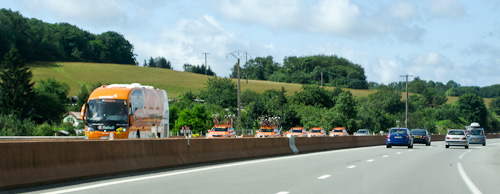
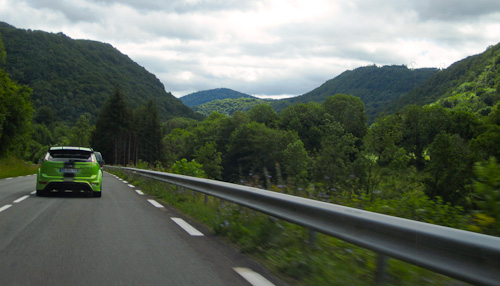



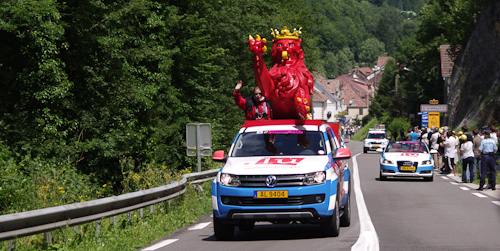
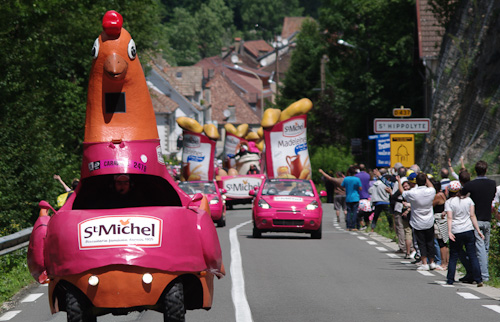
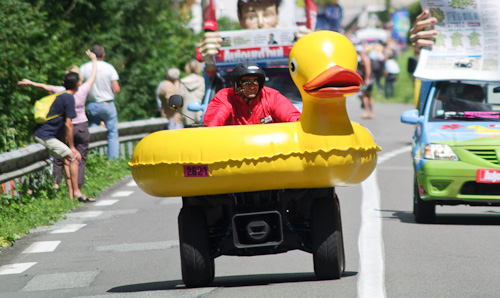
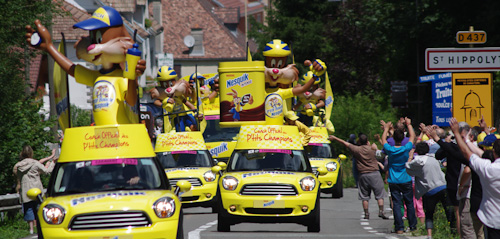






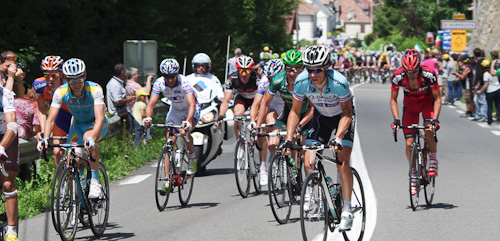
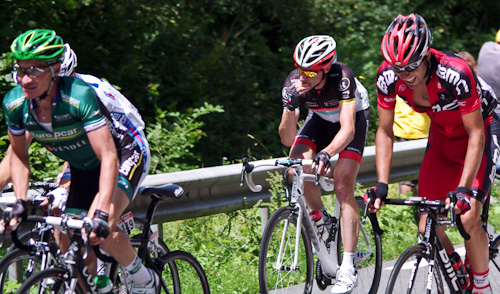
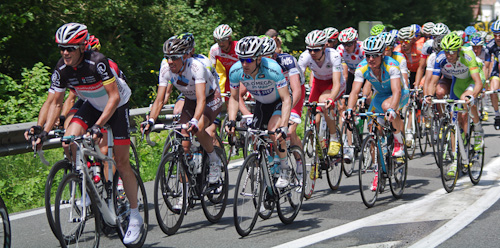

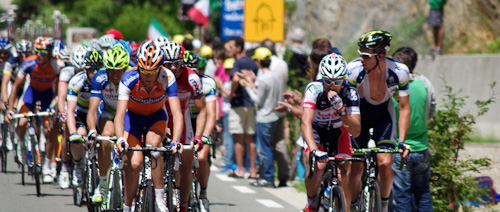
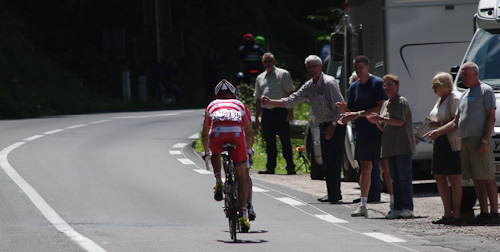

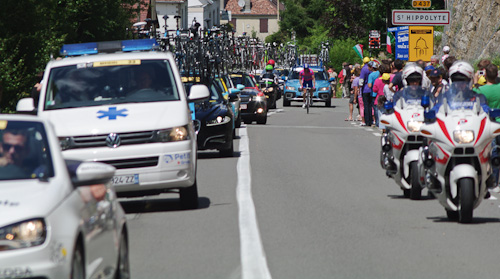
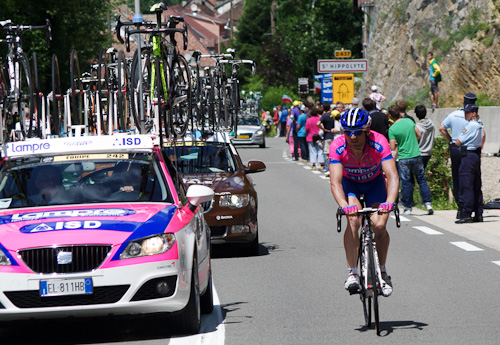
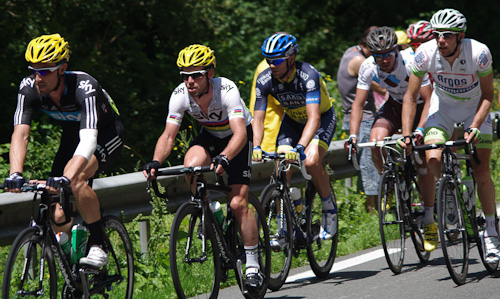
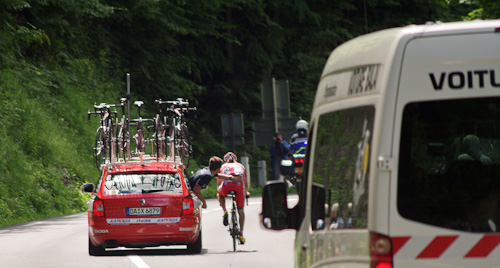

3 Comments to “Tour de France: One for the good guys”
20 November 2012
The scene with Pinot was awesome. I remember how excited the Team Director was!
Was this the Stage I saw you on the US Telecast? Flags are distinctive!
20 November 2012
This weekend, I found a 13 mile bike route in Chicagoland that climbs over 300 feet!
21 November 2012
Dave – you saw us the day before, at the last main climb before the La Planche des Belles Filles. I think we were briefly spotted on this coverage that we DVR’d, but the Great Failure of 2012 means we’ve lost that recording.
My flag was awesome and the stick totally improved it’s visibility.